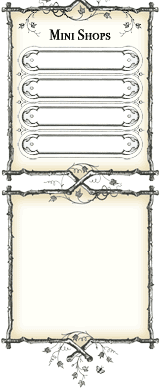Additional Notes about Crafting Tinsel Rosettes
Design Tips from our Artists
• Studio Secrets from the Blümchen Atelier •
----------------------------------------------------------------------
Want the "inside scoop" about working with Lametta tinsel?
The following crafting tips and assorted notes from our artists
will help you get started on designing and creating your own
nostalgic,
heirloom-quality
Lametta tinsel rosette ornaments.
Crafting Instructions for a Making a Standard-Size
Lametta Tinsel Rosette Ornament
6-Points • 3 ½" Wide
------------------------------------------------------------------------
These instructions will teach you all the tips and techniques
necessary to create a 3½" wide, 6-point tinsel rosette ornament.
Once you learn how to make this basic, standard rosette, you
will be delighted with how easy it is to customize the rosettes
to create your own imaginative, fanciful tinsel ornaments.
We love graph paper, and keep a ready supply
of
tablets with a 1/4" grid spacing for our artists.
During the design process, the grid
serves as a
handy guide for estimating the cut sizes of the
individual pieces used in an ornament; plus, we
also make design and measurement notations on
the graph paper to keep as
reference. When we
craft ornaments, graph paper has three aspects
that make it especially useful: first, it has a clean,
bright white surface to work on,
second, marking
a vertical, central line plus the
outer
points of the
ornament on the grid makes it easy to check that
you are crafting the ornament evenly on all sides,
and lastly,
the disposable sheets make clean-up
a breeze!
When crafting with Lametta tinsel, it's important
to
use a light touch
so as not to
crush the metal
filaments. Manufactured in Germany especially
for Blümchen, our authentic Lametta
tinsel
roping
and fringes
are made with real "Lahn," which
are
filaments produced from flattened metal wire.
This Lametta will
darken slightly over time, just
like tinsel ornaments
did back in the olden days.
In fact, the real silver
plating used is "guaranteed to tarnish" for a truly
traditional look!
-------------------------------------------------------------
-------------------------------------------------------------
The most important thing to know about modern
scrap pictures is that they are produced on a
thinner-weight paper than that used in Victorian
times. If you aren't careful to work with a light
touch, gluing a scrap relief onto the embossed
surface of a Dresden trim and
pressing it down
too
firmly can cause the scrap to
have a bumpy
appearance, which is quite unattractive on your
finished ornament! Before gluing a scrap
picture
onto an ornament,
it's a
good practice to "back"
the scrap with cardstock or thin cardboard. The
scrap can be glued directly onto the backing,
then trimmed neat.
An easier and faster way to
back a scrap is to cut a piece
of cardstock that covers
just a goodly portion of the scrap, then
glue the scrap onto it. In addition to providing additional support for the scrap, it also helps to
keep the edges of the scrap from curling.
Design tip: An advanced crafting technique is
to add a little "depth" to an ornament by slightly
raising different layers of the die-cut decorative
embellishments. We like to glue small pieces of
cardboard between the layers of
the backed
scraps
(see craft tip above) and Dresden trims
when assembling the ornament. This extra step
to ever-so-slightly separate the layers of the
decorative
embellishments is a subtle refinement
that lends a more sophisticated appearance to
your tinsel rosette ornaments.
Graph Paper as a Work Surface:
Notes & Design Tips for Lametta Tinsels:
Notes & Design Tips for Scrap Pictures:
Worried that the tinsel roping "petals" are uneven
or lopsided on your ornament? It's a cinch to fix this problem: just flip the ornament over so that
it is laying face down, then, using a pair of pliers,
grasp a bit of the wired tinsel that's close to the
crown fastener and push the tinsel in towards
the center. You can adjust each
petal until your
rosette ornament is nice and even in shape.












